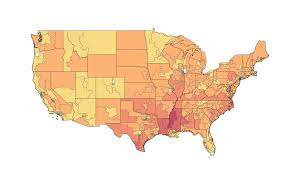
A recent study has highlighted alarming rates of leg amputations due to poor circulation in specific regions across the United States. The data, visualized through a map, reveals a troubling pattern where certain areas experience significantly higher rates of amputations, often linked to preventable medical conditions. This trend has raised concerns among healthcare professionals about the accessibility and quality of care available in these regions.
See Here:
The Link Between Poor Circulation and Amputation
Peripheral artery disease (PAD), a condition that narrows the arteries and reduces blood flow to the limbs, is one of the leading causes of leg amputations. Poor circulation resulting from PAD can lead to severe complications such as gangrene or non-healing wounds, ultimately necessitating amputation. Often, individuals with PAD also suffer from diabetes, another condition that increases the risk of amputation due to compromised circulation.
The study shows that many of these amputations could be avoided with early diagnosis and timely intervention. However, in regions with high amputation rates, there are often significant barriers to accessing quality healthcare, including a lack of preventive care, delayed treatment, and socioeconomic factors that contribute to poor health outcomes.
Regional Disparities in Amputation Rates
The map reveals that certain regions, particularly in the Southern United States, experience disproportionately high amputation rates. States like Mississippi, Louisiana, Alabama, and Arkansas have been identified as having the highest numbers of amputations related to poor leg circulation. These areas also have higher rates of chronic conditions such as diabetes and hypertension, which exacerbate the risk of amputation.
In contrast, states in the Northeast and West Coast tend to have lower amputation rates, attributed to better access to healthcare services, including vascular specialists and preventive care. The disparities in amputation rates are a stark reflection of the broader health inequities that exist across the country.
Socioeconomic Factors at Play
The study indicates that regions with higher rates of leg amputations often have higher poverty levels, limited healthcare infrastructure, and lower educational attainment. Many of the affected individuals live in rural areas, where access to specialists and advanced medical treatments is limited. In these areas, patients may not seek medical attention until their condition has progressed to a critical stage, making amputation the only viable option.
Additionally, the cost of healthcare and lack of insurance coverage play a significant role. People without adequate health coverage are less likely to receive preventive care or timely interventions, increasing the likelihood of complications that lead to amputation.
Preventive Measures and Solutions
Experts agree that many amputations could be prevented through early detection and better management of conditions like PAD and diabetes. Regular screenings for at-risk populations, improved access to vascular care, and patient education on managing chronic conditions are crucial steps in reducing amputation rates.
Healthcare providers are encouraged to adopt a more proactive approach, focusing on preventive care and early interventions, particularly in high-risk areas. Public health campaigns that raise awareness about the dangers of untreated PAD and diabetes can also help reduce the need for amputations by promoting healthier lifestyles and regular medical check-ups.
Addressing Health Inequities
Reducing the high rates of amputations in certain U.S. regions requires addressing the root causes of health inequities. Expanding healthcare access in underserved areas, investing in rural healthcare infrastructure, and improving insurance coverage for vulnerable populations are essential to curbing the rising trend of amputations.
Furthermore, community-based healthcare initiatives that bring medical professionals to underserved areas can help bridge the gap in access to care. By focusing on preventive measures and providing better support for managing chronic conditions, the healthcare system can help reduce the number of unnecessary amputations in high-risk areas.
Conclusion
The map highlighting U.S. areas with high amputation rates due to poor leg circulation underscores the critical need for improved access to healthcare and preventive services in underserved regions. By addressing the socioeconomic factors contributing to these disparities and promoting early detection and intervention, the healthcare system can work toward reducing the number of amputations and improving the overall quality of life for those at risk





